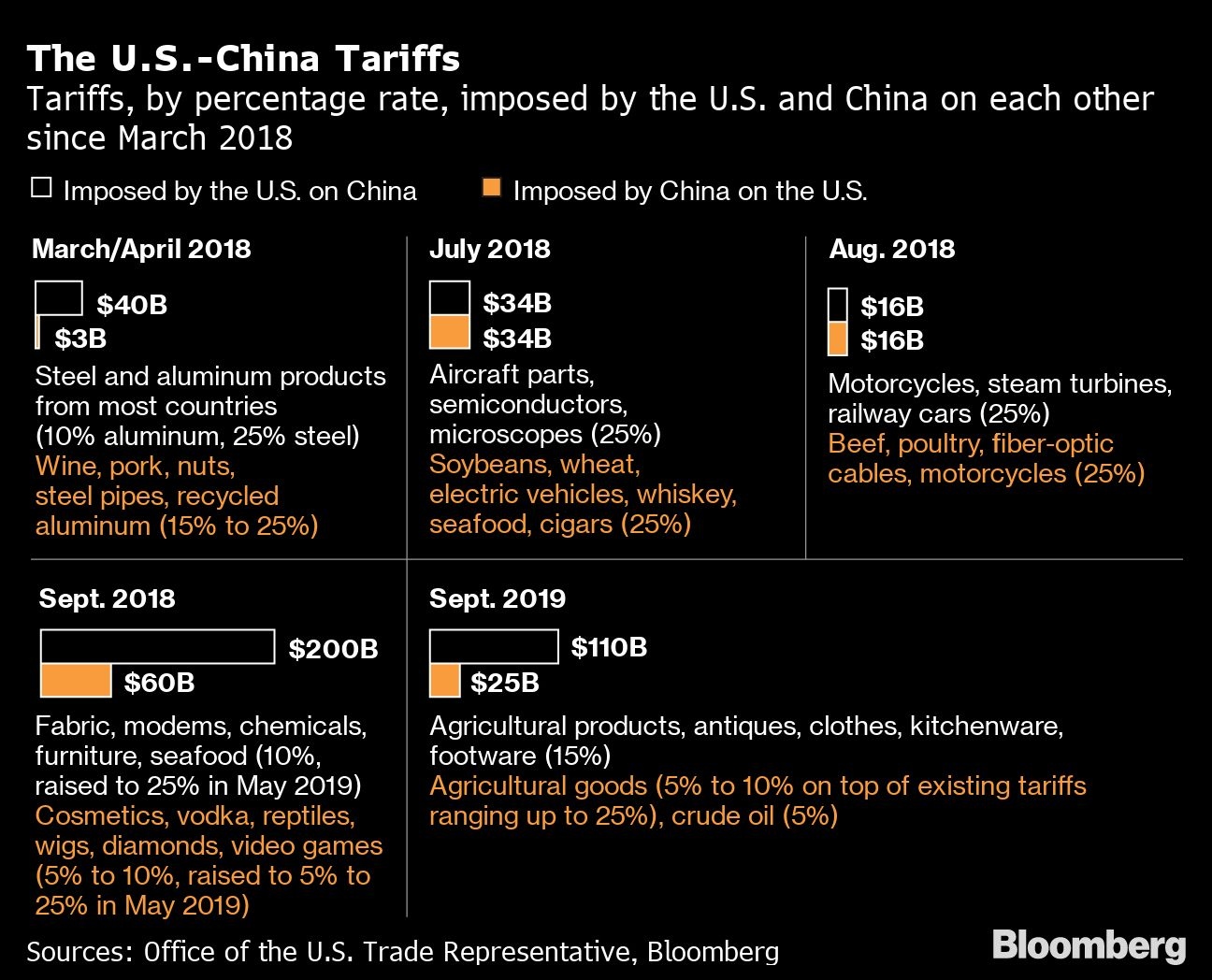Nov 19, 2019
U.S., China to tie tariff relief to failed deal from May
, Bloomberg News
U.S., China Officials Discuss Concerns of Trade Deal Phase One
The near-deal between the U.S. and China that fell apart six months ago is now being used as the benchmark to decide how much tariffs should be rolled back in the initial phase of a broader trade agreement, people familiar with the talks said.
The two sides, who are locked in tough -- perhaps final -- negotiations on a phase-one pact, are discussing linking the size of tariff rollbacks to the preliminary terms set in that failed May deal, according to the people, two of whom said the White House is still debating the precise percentage internally. The Chinese have demanded that all tariffs imposed after May be removed immediately and then tariffs imposed before that be lifted gradually, according to one of the people.
The duties under discussion for a potential rollback include the initial tariffs on some $250 billion in Chinese goods that President Donald Trump imposed last year, according to two people. Some of his advisers had been pushing to keep those in place longer term, to ensure China lives up to its end of the bargain, but now are open to a partial relief in order to get the phase one deal signed.
U.S. officials have differing views on how much phase one would cover and what portion of the tariffs the Trump administration should agree to roll back, two people familiar with the matter said. The internal figure under discussion ranges from around 35 per cent, pushed by U.S. Trade Representative Robert Lighthizer to the 60% that Trump has said the deal encompasses, according to the people, who asked not to be named because the talks are private.

Once both countries have settled on a number, either the tariff rate could be lowered by the agreed-upon percentage or tariffs could be eliminated based on that figure. Spokesmen for Lighthizer and the White House didn’t immediately respond to a request for comment.Stocks moved higher Tuesday on the news before retreating to losses on the day.
Analysts say the first phase covers significantly less than what Trump has been promising publicly because it leaves on the table most of the thorny issues at the heart of the trade dispute. There’s also widespread skepticism on both sides that the countries would ever reach a second-phase agreement that would tackle structural reforms.
Trump, who calls phase one a “substantial” agreement, for weeks has been trying to sell the deal domestically and push back at criticism on the limited scope of the agreement.
“We will finish out the large Phase One part of the deal, then head directly into Phase Two,” he tweeted on Oct. 13.
The Trump administration has import taxes in place on some $360 billion in goods from China and has threatened to impose new levies on another $160 billion in products Dec. 15.
Before the May talks collapsed and precipitated a summer of escalation, the U.S. had 25% duties on some $250 billion in imports.
The phase one deal, if finalized, would likely include the elimination of tariffs that went into effect in September and the additional batch that’s set to take effect in December, two of the people said.
'Thorough Discussions'
The linkage of a rollback with the size of the potential deal was hinted at by China’s commerce ministry last week.
“If China and the the U.S. reach a phase-one deal, the level of tariff removal should reflect the importance of the phase-one deal,” spokesman Gao Feng said. “The importance of the phase-one deal should be evaluated by both sides and the two sides are in thorough discussions.”
The Commerce Ministry didn’t respond to a faxed request for comment.
The normally closed-door negotiations have spilled out into the open recently and riled global financial markets, with the two sides confirming almost two weeks ago that they would roll back tariffs in any deal, before Trump said he’d not agreed to anything. Since then, he has threatened more tariffs if no deal is reached, even as U.S. officials have signaled the talks are in the final stages.
This is the first indication that the two sides are basing their discussion on the May deal text, which the U.S. accused China of reneging on. Trump tweeted in October that the phase one deal would cover about 60% of the “total deal,” although it’s unknown whether that total deal is the same as the May one.
Read More: A Timeline of the Trade Talks Between the U.S. and China
The move to link tariff rollback and the size of the deal appears intended to give Beijing an incentive to agree because it answers a key Chinese demand: that there be a clear path for the removal of tariffs. The lack of a promise from the U.S. to remove all the tariffs was one of the reasons China gave for the collapse of the talks in May.
But the debate over the size of the first-phase deal and the link to the duties puts Trump in a position where he may make more concessions than expected on his go-to tool of leverage -- tariffs.
The longer the negotiations drag on, the more uncertainty arises for businesses who have to plan shipments for the Christmas season and the new year. The U.S. threat to impose more tariffs next month is not yet off the table, and China has promised to retaliate.
When the two sides agreed to a limited, phase-one deal in October, there was an expectation that it would be signed in November, when the two presidents could have met at an international conference. But after the cancellation of that meeting due to civil unrest in Chile, Trump and Chinese President Xi Jinping still haven’t agreed on a new signing venue and date.
--With assistance from Scott Lanman.

